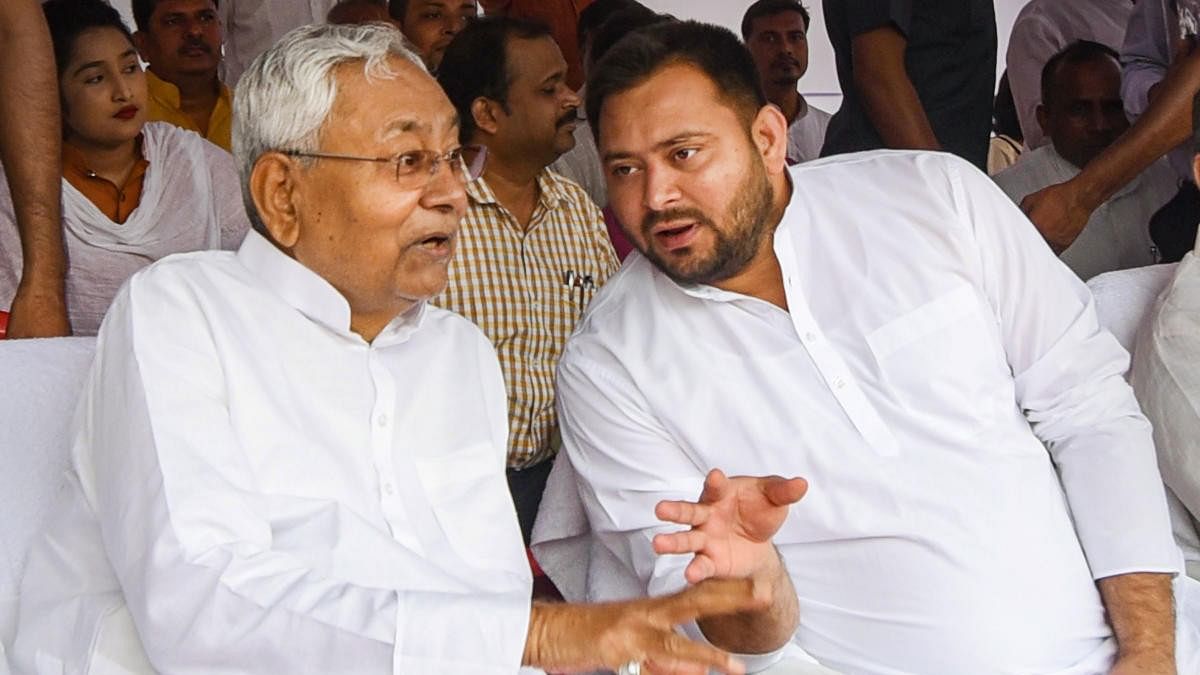
Nitish Kumar seen here with Tejashwi Yadav. Yadav was the deputy CM while Nitish remained outside the NDA but the Bihar CM has now returned to the NDA fold.
Credit: PTI Photo
The Bharatiya Janata Party (BJP), led by Prime Minister Narendra Modi, has successfully allied with the Nitish Kumar-led Janata Dal (United) and other regional parties in Bihar, aiming to replicate the National Democratic Alliance (NDA)’s 2019 performance where it won 39 of the 40 seats. The NDA had about a 20 per cent lead over the Opposition alliance of the Rashtriya Janata Dal (RJD), the Congress, and other smaller parties.
Kumar, then dubbed 'Sushasan Babu', was an unmatched political figure in Bihar, further elevated by the wave of aggressive nationalism following the Pulwama terror attack, a tragedy that deeply affected Bihar.
Kumar has been a central figure in Bihar's politics for nearly 20 years now, forming governments with the BJP six times and twice with the RJD. Despite varying electoral outcomes, he has remained at the forefront of the state's political arena.
However, Bihar’s political dynamics have undergone significant changes. Since its inception in 2003, the JD(U) contested more seats than the BJP in the 2004 and 2009 general elections. This changed in 2019 when the JD(U) rejoined the NDA, leading to an equal division of seats between the two parties (16 seats).
Under the latest agreement, the BJP will contest 17 seats, the JD(U) 16, and Chirag Paswan’s LJP (Ram Vilas) will contest five. The NDA allies — Hindustani Awam Morcha (HAM) and the Rashtriya Lok Morcha led by Upendra Kushwaha — will contest one seat each. This arrangement suggests that the BJP has become the principal political force in Bihar for the Lok Sabha elections, with the JD(U) taking a step back. Additionally, the departure of Pashupati Paras from the NDA introduces further complexity to the alliance dynamics, potentially impacting the NDA's overall cohesion and electoral strategy in Bihar.
The political landscape of Bihar in 2024 is markedly different from 2019. Kumar, once at the forefront of the opposition against the BJP, has rejoined forces with the national party he accused of attempting to dismantle the JD(U). This move led to criticism, with the BJP then dubbing him 'Paltu Ram', a label that has somewhat tarnished his political reputation. Many believe the momentum the inauguration of Ram temple in Ayodhya has created will work against Kumar and it would be difficult for the JD(U) to win in the 16 seats it will be contesting from. Furthermore, the caste census conducted by the Bihar government, seen as a significant electoral strategy, might not be as effective against the BJP's narrative.
Despite this, the BJP is confident that its control over the state's apparatus, aided by its 78 MLAs and two Deputy Chief Ministers, will favour the party in the upcoming elections.
Kumar's frequent shifts in allegiance and the perception of the JD(U) as a junior partner to the BJP in the NDA may alienate his dedicated voter base, potentially complicating the NDA's electoral prospects. Nonetheless, the BJP remains hopeful that Kumar's policies favouring the extremely backward classes and the Mahadalits will secure a reliable vote-bank for the JD(U) and, by extension, the NDA.
On the other side, the RJD, leveraging its Muslim-Yadav base, aims to challenge the NDA's dominance by expanding its social base by wooing the EBCs which form a sizable and decisive vote-bank. RJD leader Tejashwi Yadav's emphasis on unemployment and government job provision positions the RJD more favourably compared to 2019. His role in the caste census along with Kumar and efforts to enhance OBC reservations to 65 per cent have also contributed to an improved public image which may broaden the RJD's electoral appeal.
The departure of Paras from the NDA is another positive news for the I.N.D.I.A. bloc as far as the caste arithmetic is concerned.
Despite these developments, the JD(U)’s re-entry into the NDA is a significant setback to Opposition unity, enhancing the BJP's position in Bihar. The Opposition, particularly the RJD, faces the challenge of countering this momentum to secure a victory. This moment could be a turning point for Tejashwi Yadav, akin to Samajwadi Party leader Akhilesh Yadav's in 2012, offering an opportunity to captivate the youth and middle-class voters cutting across caste lines; thereby posing a real challenge to the NDA.
(Mahendra Kumar Singh is a political commentator and teaches Political Science at DDU Gorakhpur University, Uttar Pradesh. X: @MKSinghGkp.)
Disclaimer: The views expressed above are the author's own. They do not necessarily reflect the views of DH.